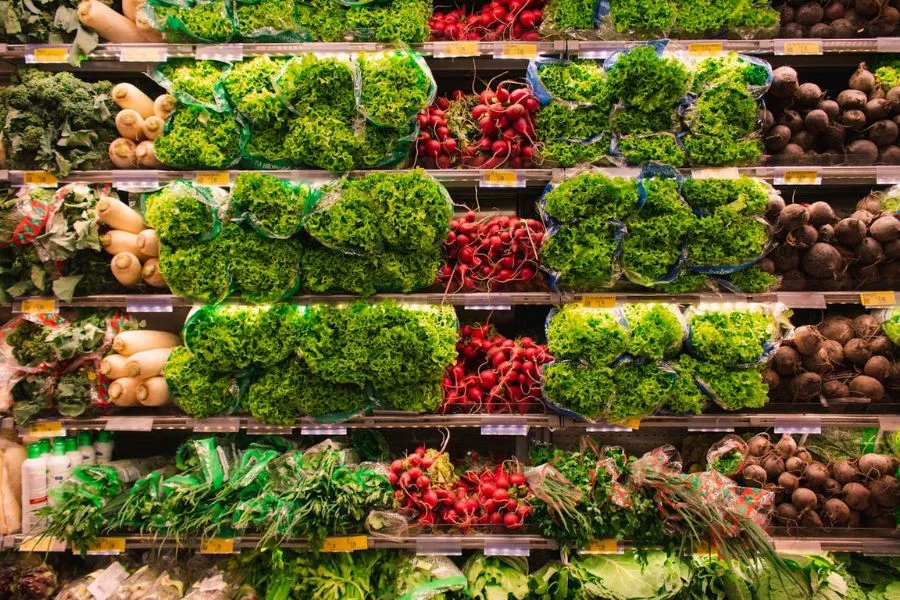This post may contain affiliate links to products or services. I may receive a commission for purchases made through these links with no cost on you. Please read my disclosure for more information.
Grocery shopping can take a significant chunk out of your budget, but there are creative ways to save money on groceries.
With prices soaring on everything from meat and produce to canned goods and frozen foods, it can feel impossible to keep your grocery budget under control.
But with a little creativity and planning, you can trim those expenses without sacrificing the quality of your meals.
21 CREATIVE WAYS TO SAVE MONEY ON GROCERIES
As a mom, it’s our job to handle the household budget, and one big area we can save money is on groceries.
By using smart strategies and making good choices, you can save money on your groceries while still eating delicious and nutritious food. Here are some ways:
1. Set a budget for groceries
Setting a budget for groceries involves determining how much you’re willing to spend on food within a certain period, such as weekly or monthly, and then sticking to that limit.
Plan your meal and grocery list based on your budget.
For example, you might decide that your grocery budget for the month is $300. You can break this down further by allocating a certain amount each week for different categories like fruits and vegetables, proteins, grains, and snacks.
Throughout the month, track your spending to ensure you’re staying within your budget, adjusting as needed.
For instance, if you find you’re overspending on snacks, you can cut back in that category to stay within your overall budget.
2. Check your pantry or fridge for food items or supplies
Challenge yourself to look through your pantry (or fridge) and see what kinds of meals you can toss together with the ingredients you already have.
Maybe you still have whole chicken shoved in the back of your freezer and some potatoes on your shelves or even canned items?
By knowing what is in your pantry or fridge, you can plan your meal according to what is available.
You might still need to buy a few items, but you’ll save a lot by using food you already have.
3. Utilize leftovers
Another way to save money on groceries is by being creative and incorporating leftovers into new dishes such as soups, stir-fries, casseroles, or salads.
For example, leftover chicken can be used in sandwiches, wraps, soups or tossed with vegetables for a quick stir-fry.
This reduces food waste and saves you from having to buy additional ingredients.
4. Make a simple meal plan
Having an inventory of your pantry and fridge, you may likely to have an idea what meals you could prepare for the week.
Before heading to the grocery store, plan your meals for the week. This way, you can make a shopping list based on what you need, reducing the chances of impulse purchases.
Tips for planning your meal to save money on groceries:
- Try going for a meatless meal once or twice a week. Meat is often one of the most expensive items on a grocery list. Consider incorporating more plant-based meals into your plan to save money.
- Swap expensive cuts of meat for cheaper options. Check for recipes for meat cuts that are less expensive than your usual choices. Instead of getting chicken breast, opt on whole chicken and cut it yourself.
- If you need to buy meat, buy only when it is on sale.If it is necessary to buy a specific cut or kind of meat, keep an eye for discounts.
- Incorporate in your meal plan some affordable protein sources like beans, lentils, tofu, or eggs in some meals to cut down on costs.
- Put more green vegetables in your plate for a fuller and healthier meals.
- Plan your meals around seasonal produce to save money.
5. Shop on full stomach
Shopping on full stomach helps curb impulse purchases of unhealthy or unnecessary items, as you’re less likely to be tempted by hunger-driven cravings.
Additionally, it allows you to make more rational and budget-conscious decisions, focusing on essential items rather than indulgences.
Lastly, shopping with a satisfied appetite can enhance your overall grocery shopping experience, making it more efficient and enjoyable.
6. Shop solo if you can

Shopping with children or a partner may increase the likelihood you’ll buy something on a whim.
It is also makes it easier to stick to your budget since you’re not influenced by others’ preferences or tempted to make impulse purchases. Because whether we like it or not, your child will ask for something when on the grocery store and there are instances that you can’t say “no”.
To prevent anything like this to happen and to free yourself from guilt (of not buying what your child/ spouse wants), try shopping alone.
7. Shop during weekdays or quietest days of the week
Shopping during quieter times means you’re more likely to find freshly stocked produce and other perishable items, ensuring higher quality and longer shelf life.
Also, with fewer shoppers milling about, it’s easier to take a good look at the selection and find brands that are most cost effective without having to weave through crowded aisles or dodge shopping carts.
Some stores may offer discounts or markdowns on certain items during weekdays to attract more customers, providing an opportunity for savings.
If going on a weekend isn’t doable, just try to avoid the weekends. Larger crowd equal fewer deals.
8. Check for “Sale”
Be sure to check your local newspaper circulars or store apps to know what’s on sale and when.
You can plan your menu based on what’s currently on sale, especially when it comes to items such as meat and fish.
Everyone loves a deal, but make sure not to buy items you don’t really need. Don’t buy something just because it’s on sale or because you have a coupon.
However, if you consume certain foods in large quantities, then buy in bulk then freeze the rest. For instance, you may find a deal that applies when you purchase two loaves of bread or two packages of cheese. Rather than trying to use it all at once, freeze the spare for later.
Also, it pays to know the “sale” cycles. Based on my experience, grocery stores have their “sale” before holidays (like Christmas, new year, etc.), or pay day.
9. Calculate as you shop
You can use either your smartphone or a handheld calculator to add up the cost of your groceries as you go through the aisles.
This can be especially helpful if you’re sticking to a strict budget.
However, there is a fun way you can calculate your items without using a calculator or phone and that is by rounding up each item’s price in your cart.
For example, the $1.49 product becomes $2, $7.75 item becomes $8—you get the idea.
If you apply this method to everything in your cart, you’ll still have a rough idea of your expenses, but you’ll be pleasantly surprised at the checkout counter and paying below your budget.
10. Buy generic or store brands
Generic or store-brand products often are more affordable than name brands, allowing you to save money on your groceries.
Also, many generic or store brand products are manufactured by the same companies that produce name brands, meaning they often have similar quality but at a lower price.
You can experiment with the generic brands and see if it suits you.
11. Avoid pre-cut, pre-packaged and pre-cooked foods
Pre-cut fruits and vegetables, individually packaged snacks, and pre-cooked meals are convenient but can be costly. Buy whole foods and cook or prepare them. Yes, you’ll have to spend a little extra time chopping and prepping, but it’s more money back in your wallet.
And instead of buying items like salad dressing, marinades, or sauces, try making them from scratch using basic ingredients like olive oil, vinegar, herbs, and spices.
12. Shop in-season

Shopping for in-season fruits and vegetables offers fresher produce at peak flavor and nutritional value.
In-season produce is often more abundant, leading to lower prices and cost savings for shoppers.
Additionally, buying in-season supports local farmers and reduces the environmental impact associated with transportation and storage of out-of-season produce.
13. Utilize frozen fruits and vegetables
Frozen produce are often more convenient as they have a longer shelf life and are ready to use straight from the freezer, reducing food waste.
Additionally, frozen fruits and vegetables retain their nutrients well, as they are typically frozen shortly after harvest, preserving their nutritional content.
They can also be more cost-effective than fresh produce, allowing you to enjoy a variety of fruits and vegetables year-round without breaking the bank.
14. Buy in bulk for non-perishable items
Certain non-perishable items, such as rice, pasta, oatmeal, and canned goods, are often more cost-effective when purchased in bulk.
Just be mindful of the shelf life and storage requirements to avoid waste.
Also make sure to compare prices per unit to ensure you’re getting the best deal.
15. Take advantage of bulk bins
Purchase grains, nuts, seeds, and spices from bulk bins. This allows you to purchase only the amount you need, reducing packaging waste and saving money compared to pre-packaged options.
Another advantage of using bulk bins at grocery stores is the opportunity to try new foods without committing to a large quantity.
Since you can purchase small amounts of different items, you can experiment with new ingredients and flavors in your cooking or baking without the risk of wasting unused portions.
This can expand your culinary repertoire and add variety to your meals.
16. Avoid the center or inside aisles

Shop in the perimeter of the store where fresh produce, dairy, and meats are typically located, and avoid the centre aisles where processed and unhealthy foods are often displayed.
By avoiding buying junk and sweet foods, you can save money in the long run by reducing unnecessary expenses on unhealthy snacks and treats.
Opting for nutritious, whole foods often proves to be more cost-effective as they tend to be less processed and cheaper per serving.
Additionally, prioritizing healthier options can help prevent future healthcare costs associated with diet-related illnesses, ultimately leading to greater financial savings.
Your food budget (and your jeans) will thank you later.
17. Ignore eye-level items
When you’re avoiding items that might lead to higher costs, remember the saying, “Eye level is buy level.”
Grocery stores strategically place more expensive items at eye level to catch your attention.
Have you ever noticed how the priciest items are right in front of you? That’s intentional; stores want you to splurge.
Instead of falling into these marketing traps, take a moment to look up and down the shelves as you shop. You’ll often find more affordable options placed higher or lower. Think of it as a treasure hunt for the best deals.
16. Use coupons, points, and discounts
Keep an eye out for coupons, discounts, and sales both online and in-store.
Many grocery stores offer free loyalty programs that offer points, discounts, or cash back for loyal customers.
Consider signing up for newsletters or apps that notify you of current promotions, allowing you to plan your shopping accordingly.
19. Compare prices across stores near you
If you’re fortunate to have several groceries stores close by, consider comparing products and prices at each one and shop where you discover the most favorable deals.
It may not be practical to dash around too much to gather all your groceries, but you could allocate a couple of different days in the week to visit various stores.
This may also require some extra time but can lead to significant savings.
You can use online tools and apps to streamline the price comparison process.
When you keep on doing this, you will know which items are cheaper in one store, their sale cycle, loyalty program and you can take advantage of it.
20. Meal prep over the weekend
Meal prepping during weekends saves you time during busy weekdays by preparing meals in advance, promoting consistent eating habits and portion control.
You can prepare large batches on a Saturday or Sunday and freeze them in smaller portions.
It is cost-effective, as bulk buying ingredients and cooking at home reduces expenses and minimizes food waste for you. It helps you prevent the urge to eat out or order takeout, ultimately saving you money.
Additionally, meal prepping provides convenience, variety, and healthier choices, reducing stress and supporting your overall wellness goals throughout the week.
21. Grow your own produce

If you have space and time, consider starting a small vegetable garden to grow your own herbs, fruits, and vegetables, reducing your reliance on store-bought produce.
This can significantly reduce your grocery bill, especially during the growing season.
Herbs like basil, parsley, cilantro, and mint are excellent choices for home gardens and can be grown indoors or outdoors in containers.
Additionally, lettuce, spinach, kale, and other salad greens are perfect for home gardens, especially in cooler climates or during the cooler seasons.
REASONS TO SAVE MONEY ON GROCERIES
Spending less on groceries benefits you financially, enabling you to allocate resources to other priorities or savings like emergency or retirement fund.
It promotes better budgeting habits, helping you manage expenses effectively and potentially reduce debt.
Additionally, it encourages mindful shopping, leading to less food waste and more efficient meal planning for your household.
By prioritizing essential purchases, you can maintain a balanced diet while staying within your budgetary constraints.
A good motivator to decrease your grocery spending can be rewarding yourself for a job well done.
This can be as small as an occasional trip to the gourmet coffee shop or as large as taking your accumulated savings over time and devoting it to a vacation.
CONCLUSION
With these creative strategies, you can slash your grocery bill while still enjoying delicious and nutritious meals.
By planning ahead, being mindful of your purchases, and taking advantage of discounts and savings opportunities, you’ll be well on your way to saving money on groceries without sacrificing quality.
Remember, small changes can add up to significant financial benefits, allowing you to enjoy quality meals without breaking the bank. Happy shopping!
ACTION PLAN
1. Set your budget for groceries.
2. Make a simple meal plan.
3. Create your grocery list. Tip: You can download my FREE grocery list.
4. Check for sale, discounts, or promotions.
5. Be mindful of the tips mentioned above while shopping.
6. Enjoy your shopping and saving.





